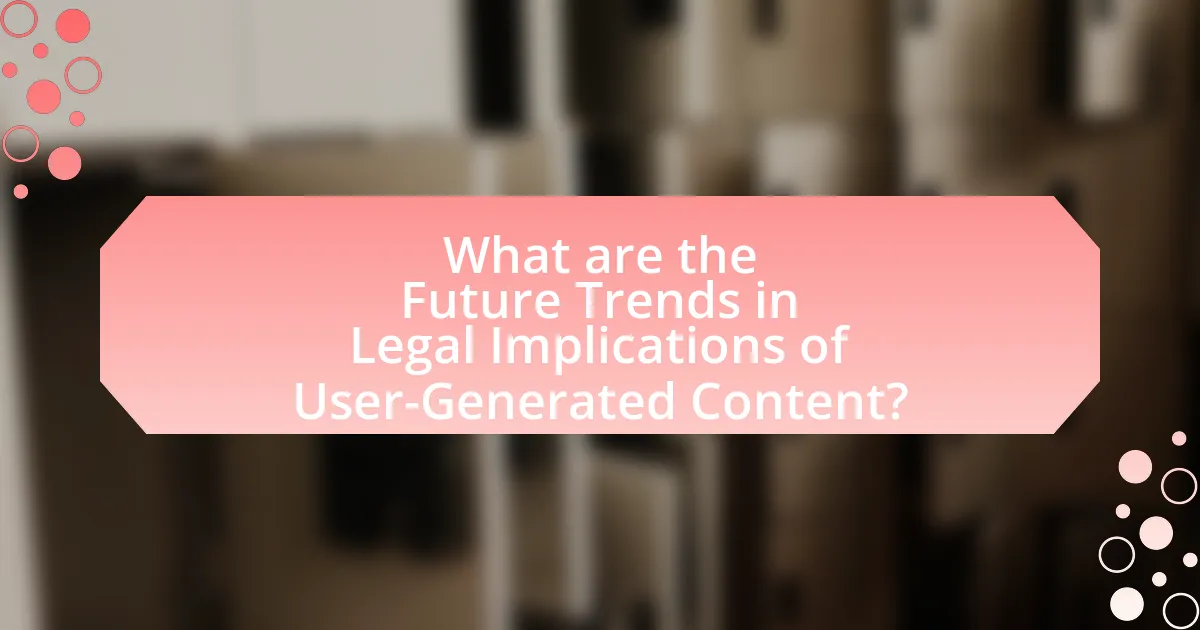User-generated content in storage platforms presents significant legal implications, particularly regarding copyright, liability, and data protection. The article explores how copyright laws protect user ownership while imposing responsibilities on platforms to manage infringing content under the Digital Millennium Copyright Act (DMCA). It discusses the types of user-generated content commonly stored, the potential legal risks such as defamation and liability for harmful content, and the importance of clear terms of service. Additionally, the article examines the impact of different jurisdictions on regulations, the role of technology in content moderation, and best practices for compliance with evolving legal standards.
What are the Legal Implications of User-Generated Content in Storage Platforms?

 |
|
User-generated content in storage platforms raises significant legal implications, primarily concerning copyright, liability, and data protection. Copyright law dictates that users retain ownership of their content, but storage platforms may face liability for infringing on third-party rights if they host copyrighted material without permission. The Digital Millennium Copyright Act (DMCA) provides a safe harbor for platforms, allowing them to avoid liability if they promptly remove infringing content upon notification. Additionally, platforms must comply with data protection regulations, such as the General Data Protection Regulation (GDPR) in Europe, which mandates user consent for data processing and imposes strict guidelines on data storage and user privacy. These legal frameworks highlight the need for storage platforms to implement robust content moderation and compliance strategies to mitigate legal risks associated with user-generated content.
How does user-generated content impact legal responsibilities for storage platforms?
User-generated content significantly impacts the legal responsibilities of storage platforms by exposing them to potential liability for copyright infringement and other illegal activities. When users upload content, storage platforms may be held accountable if they fail to act upon knowledge of infringing material, as established by the Digital Millennium Copyright Act (DMCA) in the United States, which requires platforms to remove infringing content upon notification. Additionally, platforms must implement measures to prevent the storage and distribution of harmful or illegal content, as failure to do so can lead to legal repercussions, including lawsuits and regulatory penalties.
What types of user-generated content are commonly stored on these platforms?
User-generated content commonly stored on platforms includes text, images, videos, audio files, and reviews. These types of content are prevalent because they allow users to express opinions, share experiences, and create community engagement. For instance, social media platforms like Facebook and Instagram primarily host images and videos shared by users, while platforms like Yelp and TripAdvisor focus on text-based reviews. The diversity of user-generated content enhances user interaction and contributes to the platforms’ overall value and functionality.
How do copyright laws apply to user-generated content?
Copyright laws apply to user-generated content by granting creators exclusive rights to their original works, which includes text, images, videos, and music uploaded by users. These laws protect the expression of ideas rather than the ideas themselves, meaning that while users own the copyright to their creations, they may also grant platforms a license to use that content under specific terms. For instance, many social media platforms require users to agree to terms of service that allow the platform to display and distribute user-generated content, which can lead to complex legal scenarios regarding ownership and usage rights. The U.S. Copyright Act of 1976 establishes these principles, emphasizing that copyright protection is automatic upon creation, thus reinforcing the importance of understanding how these laws impact both users and platforms.
What are the potential legal risks associated with user-generated content?
User-generated content poses several potential legal risks, including copyright infringement, defamation, and liability for harmful content. Copyright infringement occurs when users upload content that they do not own or have permission to use, which can lead to legal action from copyright holders. Defamation risks arise when user-generated content contains false statements that harm an individual’s reputation, potentially resulting in lawsuits. Additionally, platforms may face liability for hosting harmful content, such as hate speech or misinformation, under laws like Section 230 of the Communications Decency Act, which provides some immunity but does not protect against all forms of illegal content. These legal risks highlight the importance of monitoring and managing user-generated content effectively.
How can storage platforms be held liable for infringing content?
Storage platforms can be held liable for infringing content if they fail to take appropriate action upon receiving notice of infringing material. Under the Digital Millennium Copyright Act (DMCA), storage platforms must act expeditiously to remove or disable access to infringing content once they are made aware of it. If they do not comply, they may lose their safe harbor protections, which shield them from liability for user-generated content. Courts have upheld this principle, as seen in cases like Viacom International Inc. v. YouTube, where the platform’s knowledge of infringing content influenced its liability status.
What role do terms of service play in mitigating legal risks?
Terms of service play a crucial role in mitigating legal risks by establishing clear guidelines and expectations for user behavior and content management. These agreements define the legal relationship between the service provider and users, outlining rights, responsibilities, and limitations of liability. By explicitly stating prohibited activities and the consequences of violations, terms of service help protect the platform from potential legal claims, such as copyright infringement or defamation. For instance, a well-drafted terms of service can include clauses that limit the provider’s liability for user-generated content, thereby reducing exposure to lawsuits. Additionally, they often include dispute resolution mechanisms, which can further shield the platform from costly litigation.
What are the best practices for managing user-generated content legally?
The best practices for managing user-generated content legally include implementing clear terms of service, obtaining user consent, monitoring content for compliance, and ensuring proper copyright management. Clear terms of service outline user responsibilities and rights, which helps mitigate legal risks. Obtaining user consent for content use ensures that users are aware of how their contributions will be utilized, reducing potential disputes. Monitoring content for compliance with legal standards, such as hate speech or defamation laws, is essential to avoid liability. Additionally, proper copyright management, including respecting intellectual property rights and providing attribution when necessary, protects against infringement claims. These practices are supported by legal frameworks such as the Digital Millennium Copyright Act (DMCA), which provides guidelines for handling copyright issues related to user-generated content.
How can platforms ensure compliance with copyright laws?
Platforms can ensure compliance with copyright laws by implementing robust content moderation systems that identify and manage copyrighted material. These systems can utilize automated tools, such as digital fingerprinting and content recognition technologies, to detect unauthorized use of copyrighted works. For instance, platforms like YouTube employ Content ID, which scans uploaded videos against a database of copyrighted content, allowing rights holders to claim or block infringing uploads. Additionally, platforms should establish clear user agreements that outline copyright responsibilities and provide educational resources to inform users about copyright laws. This proactive approach not only mitigates legal risks but also fosters a culture of respect for intellectual property among users.
What measures can be taken to protect against liability?
To protect against liability, storage platforms should implement clear user agreements that outline responsibilities and limitations of liability. These agreements should include terms of service that specify acceptable use, user obligations, and the platform’s rights to remove harmful content. Additionally, platforms can establish robust content moderation practices to monitor and manage user-generated content effectively. Implementing a notice-and-takedown system allows platforms to respond promptly to copyright infringement claims, thereby reducing potential legal exposure. Furthermore, obtaining appropriate insurance coverage can provide financial protection against claims arising from user-generated content. These measures collectively help mitigate risks associated with liability in the context of user-generated content.
How do Different Jurisdictions Affect User-Generated Content Regulations?

 |
|
Different jurisdictions significantly affect user-generated content regulations by establishing varying legal frameworks that govern the responsibilities of platforms and users. For instance, the European Union’s General Data Protection Regulation (GDPR) imposes strict data protection and privacy requirements, compelling platforms to ensure user consent and data security. In contrast, the United States operates under Section 230 of the Communications Decency Act, which provides broad immunity to platforms from liability for user-generated content, fostering a more permissive environment for content sharing. These differences lead to diverse compliance obligations, impacting how platforms manage user content and respond to legal challenges across regions.
What are the key differences in user-generated content laws across regions?
User-generated content laws vary significantly across regions, primarily influenced by local regulations regarding copyright, liability, and privacy. In the United States, Section 230 of the Communications Decency Act provides broad immunity to platforms for user-generated content, allowing them to avoid liability for what users post. Conversely, the European Union’s Digital Services Act imposes stricter obligations on platforms to monitor and remove illegal content, reflecting a more proactive regulatory approach. Additionally, countries like Germany enforce the NetzDG law, which mandates swift removal of hate speech and other illegal content, highlighting regional differences in enforcement and compliance requirements. These variations underscore the need for platforms to adapt their policies based on the legal landscape of each region.
How do the EU’s GDPR regulations impact user-generated content?
The EU’s GDPR regulations significantly impact user-generated content by imposing strict data protection requirements on platforms that host such content. These regulations mandate that platforms obtain explicit consent from users before collecting or processing their personal data, which includes any information that can identify an individual. Additionally, GDPR grants users rights over their data, such as the right to access, rectify, or delete their information, thereby influencing how platforms manage and store user-generated content. Non-compliance with GDPR can result in substantial fines, reinforcing the necessity for platforms to implement robust data protection measures and transparent user agreements.
What unique challenges do platforms face in the U.S. legal landscape?
Platforms in the U.S. legal landscape face unique challenges primarily related to liability for user-generated content. These challenges include navigating complex regulations such as Section 230 of the Communications Decency Act, which provides some immunity from liability for platforms hosting third-party content, yet also leaves them vulnerable to state-level laws that can impose stricter standards. Additionally, platforms must contend with varying interpretations of copyright law, privacy regulations, and the increasing scrutiny from government agencies regarding data protection and user privacy. The evolving nature of these laws creates uncertainty, making it difficult for platforms to develop consistent compliance strategies.
How can platforms navigate international legal complexities?
Platforms can navigate international legal complexities by implementing robust compliance frameworks that account for varying laws across jurisdictions. This involves conducting thorough legal research to understand the specific regulations governing user-generated content in each country where the platform operates. For instance, platforms must adhere to the General Data Protection Regulation (GDPR) in the European Union, which imposes strict data privacy requirements, while also complying with the Digital Millennium Copyright Act (DMCA) in the United States, which addresses copyright issues. By establishing clear policies, engaging local legal experts, and utilizing technology for compliance monitoring, platforms can effectively manage legal risks associated with international operations.
What strategies can be employed to comply with multiple jurisdictions?
To comply with multiple jurisdictions, organizations should implement a comprehensive legal compliance strategy that includes understanding local laws, utilizing technology for data localization, and establishing clear policies for user-generated content. Understanding local laws involves researching and interpreting the specific regulations that apply in each jurisdiction, which can vary significantly, especially regarding data privacy and intellectual property rights. Utilizing technology for data localization ensures that data is stored and processed in compliance with local regulations, as some jurisdictions require data to remain within their borders. Establishing clear policies for user-generated content helps organizations manage risks associated with user submissions, ensuring that content adheres to legal standards across different regions. These strategies are essential for mitigating legal risks and ensuring compliance in a complex legal landscape.
How do treaties and agreements influence user-generated content laws?
Treaties and agreements significantly influence user-generated content laws by establishing international standards and frameworks that govern content creation and distribution. For instance, treaties like the Berne Convention for the Protection of Literary and Artistic Works set baseline copyright protections that member countries must adhere to, thereby shaping national laws on user-generated content. Additionally, agreements such as the Digital Millennium Copyright Act (DMCA) in the United States reflect international norms by providing a legal framework for addressing copyright infringement in digital spaces, which directly impacts how platforms manage user-generated content. These legal instruments create a cohesive environment that encourages compliance and harmonization of laws across jurisdictions, ultimately affecting how user-generated content is regulated globally.
What are the Future Trends in Legal Implications of User-Generated Content?

 |
|
Future trends in the legal implications of user-generated content (UGC) include increased regulation, evolving copyright laws, and enhanced liability frameworks for platforms hosting UGC. As governments worldwide recognize the impact of UGC on society, they are likely to implement stricter regulations to protect users and intellectual property rights. For instance, the European Union’s Digital Services Act aims to hold platforms accountable for harmful content, indicating a shift towards greater responsibility for online intermediaries. Additionally, copyright laws are expected to adapt to the realities of digital sharing, potentially leading to new licensing models that balance creator rights with user freedoms. Furthermore, as courts address cases involving UGC, precedents will shape liability standards, influencing how platforms manage and moderate content. These trends reflect a dynamic legal landscape responding to the complexities of digital communication and content creation.
How is technology shaping the legal landscape for user-generated content?
Technology is significantly shaping the legal landscape for user-generated content by introducing new frameworks for copyright, liability, and content moderation. The rise of digital platforms has led to the implementation of laws like the Digital Millennium Copyright Act (DMCA), which provides a safe harbor for platforms hosting user-generated content, as long as they comply with takedown requests for infringing material. Additionally, advancements in artificial intelligence and machine learning are enabling more efficient content moderation, which influences legal standards regarding the responsibility of platforms to monitor and manage user content. These technological developments necessitate ongoing adaptations in legal interpretations and regulations to address issues such as fair use, user privacy, and the balance between freedom of expression and content control.
What role does artificial intelligence play in content moderation?
Artificial intelligence plays a crucial role in content moderation by automating the detection and filtering of inappropriate or harmful content across various platforms. AI algorithms analyze user-generated content in real-time, identifying violations of community guidelines, such as hate speech, graphic violence, or misinformation. For instance, platforms like Facebook and YouTube utilize machine learning models that have been trained on vast datasets to improve accuracy in content classification, achieving up to 94% accuracy in identifying hate speech. This automation not only enhances efficiency but also helps in scaling moderation efforts to handle the massive volume of content generated daily, thereby reducing the burden on human moderators.
How might emerging technologies affect copyright enforcement?
Emerging technologies may significantly complicate copyright enforcement by enabling easier reproduction and distribution of copyrighted materials. For instance, advancements in artificial intelligence and machine learning can facilitate the creation of content that closely mimics existing works, making it challenging to identify infringement. Additionally, blockchain technology offers potential solutions for tracking ownership and usage rights, yet its implementation is still in early stages and not universally adopted. The rise of decentralized platforms further complicates enforcement, as they often operate outside traditional legal jurisdictions, making it difficult for copyright holders to pursue claims effectively.
What should platforms anticipate regarding future regulations?
Platforms should anticipate increased scrutiny and stricter regulations concerning user-generated content. Regulatory bodies are increasingly focusing on issues such as data privacy, content moderation, and liability for harmful content. For instance, the European Union’s Digital Services Act, which aims to hold platforms accountable for the content they host, exemplifies this trend. Additionally, ongoing discussions around Section 230 of the Communications Decency Act in the United States indicate potential changes that could impact platforms’ legal protections. These developments suggest that platforms must proactively adapt their policies and practices to comply with evolving legal standards and mitigate risks associated with user-generated content.
How can platforms prepare for potential changes in legislation?
Platforms can prepare for potential changes in legislation by implementing proactive compliance strategies and regularly updating their policies. This includes conducting thorough legal audits to identify areas of vulnerability, engaging with legal experts to interpret emerging laws, and establishing flexible operational frameworks that can adapt to new regulations. For instance, platforms like Facebook and Google have invested in compliance teams and technology to monitor legislative developments, ensuring they can swiftly adjust their practices in response to changes. This approach not only mitigates legal risks but also fosters trust with users by demonstrating a commitment to regulatory adherence.
What proactive measures can be taken to adapt to evolving legal standards?
To adapt to evolving legal standards, organizations should implement continuous legal education and compliance training for employees. This proactive measure ensures that staff remain informed about changes in laws and regulations affecting user-generated content. Regularly updating internal policies and procedures in response to new legal developments further reinforces compliance. For instance, the Digital Millennium Copyright Act (DMCA) requires platforms to respond promptly to copyright infringement claims, necessitating ongoing training on these obligations. Additionally, engaging legal counsel to conduct periodic audits can identify potential compliance gaps, allowing organizations to address issues before they escalate.
What are the best practices for ensuring compliance with user-generated content laws?
To ensure compliance with user-generated content laws, platforms must implement robust content moderation policies. These policies should include clear guidelines for acceptable content, regular training for moderators, and the use of automated tools to detect and filter inappropriate material. Additionally, platforms should establish a transparent reporting mechanism for users to flag violations, ensuring timely responses to complaints. Compliance can be further reinforced by maintaining accurate records of user activity and content removal actions, which can serve as evidence in case of legal disputes. Regular audits of content moderation practices can also help identify areas for improvement and ensure adherence to evolving legal standards.
How can platforms develop effective content moderation policies?
Platforms can develop effective content moderation policies by establishing clear guidelines that define acceptable and unacceptable content. These guidelines should be informed by legal standards, community values, and user feedback to ensure they are relevant and enforceable. Research indicates that platforms with transparent policies and consistent enforcement mechanisms experience higher user trust and compliance. For instance, a study by the Pew Research Center found that 70% of users prefer platforms that clearly outline their content moderation practices. Additionally, employing a combination of automated tools and human moderators can enhance the effectiveness of these policies, as automation can quickly flag potential violations while human oversight ensures context is considered.
What resources are available for legal guidance on user-generated content?
Legal guidance on user-generated content can be found through various resources, including legal textbooks, online legal databases, and industry-specific guidelines. Legal textbooks such as “Copyright Law: Essential Cases and Materials” provide foundational knowledge on copyright issues related to user-generated content. Online legal databases like Westlaw and LexisNexis offer access to case law, statutes, and legal commentary that address user-generated content. Additionally, organizations such as the Electronic Frontier Foundation provide guidelines and resources specifically focused on the legal implications of user-generated content in digital platforms. These resources collectively help individuals and organizations navigate the complexities of legal issues surrounding user-generated content.


